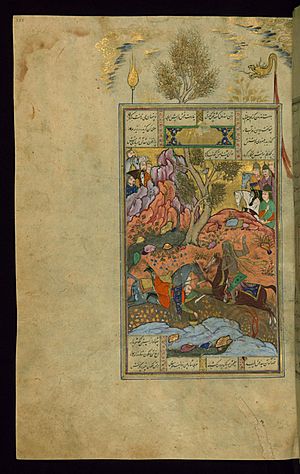Daqiqi facts for kids
Quick facts for kids
Daqiqi
دقیقی |
|
|---|---|
| Native name |
دقیقی
|
| Born | Abu Manṣūr Muḥammad ibn Ahmad Daqīqī c. 935 Tus, Khorasan, Samanid Empire |
| Died | 977 |
| Occupation | Poet |
| Language | Persian |
| Genre | Persian poetry, national epic |
| Subject | Persian revivalism |
| Notable works | Writing the story of Gushtasp in the Shahnameh |
Daqiqi (whose full name was Abu Mansur Muhammad ibn Ahmad Daqiqi) was a very important Persian poet. He lived during the time of the Samanid Empire. He was the first person to start writing a huge national poem for Iran called the Shahnameh, or "The Book of Kings."
Sadly, Daqiqi was killed in 977. He had only written about 1,000 lines of the poem. Another famous poet, Ferdowsi, later continued Daqiqi's work. Ferdowsi became one of the most important figures in Persian literature.
What's in a Name?
Daqiqi's personal name was Muhammad ibn Ahmad. His family name was Abu Mansur. So, his full name was Abu Mansur Muhammad ibn Ahmad Daqiqi.
However, most people knew him by his pen-name, Daqiqi. This name means "accurate" in both Arabic and Persian.
Life and Times
Daqiqi was born around the year 935. Like many educated people of his time, he likely came from a family of Iranian landowners. This period was a time of great growth for literature, especially poetry.
The Samanid Empire played a big role in this. Under their rule, Persian literature became very popular and was officially recognized. This new Persian literature grew strong in areas like Transoxiana and Khorasan, not just in Fars, which was the traditional home of the Persians.
There is some debate about where Daqiqi was born. Cities like Bukhara, Samarkand, Balkh, Merv, and Tus have all been suggested. Tus seems to be the most likely place.
His exact religious beliefs are also debated by experts. Even though he had a Muslim name, some scholars believe he might have secretly followed Zoroastrianism. This was an ancient Persian religion. Other experts think he might have been a follower of Shia Islam. Many Shia Muslims were proud of their old Iranian history.
Daqiqi's Work

Daqiqi started his career working for a local ruler in a place called Chaghaniyan. Later, the Samanid ruler, Mansur I, invited him to his royal court.
The Samanid rulers were very interested in old Iranian stories and heroic tales. This interest inspired Daqiqi to start writing the Shahnameh. This long epic poem was meant to tell the history of the Iranian people.
Sadly, Daqiqi was reportedly killed by his own slave in 977. He had only finished a small part of the Shahnameh. This part was about a conflict between two characters named Gushtasp and Arjasp.
Because there was so much interest in ancient Iranian history, Ferdowsi decided to continue Daqiqi's work. Ferdowsi finished the Shahnameh in 994. He later created a second, longer version in 1010.
Daqiqi's original 1,000 lines were kept in the Shahnameh. However, Ferdowsi thought Daqiqi's writing style was a bit old-fashioned. He felt it was not as rich with comparisons and vivid descriptions as his own poetry. Even so, Daqiqi's contribution was an important start to this great national epic.
See also
 In Spanish: Abu Mansur Daqiqi para niños
In Spanish: Abu Mansur Daqiqi para niños

